This post was originally crafted by Jason Kurylo in June of 2011. It has been updated by a current THW writer, Trevor Beggs, in September of 2018.
Since joining the NHL in 1970, the Vancouver Canucks have had 13 team captains. Some were boxers, some were bruisers, some were pluggers, some were Swedes. One guy was a goalie who won Olympic gold with Team Canada, one guy was a defenseman who won Olympic gold with Team Canada’s women’s team, and one guy was vilified before going into the Hall of Fame. You want ’em, you got ’em: every team captain in Vancouver Canucks history.
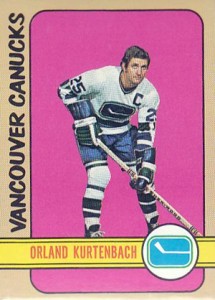
Orland Kurtenbach, #25, 1970 – 1974
Orland Kurtenbach was known as a gentleman off the ice, but one of the game’s toughest fighters on it. He played with the WHL Vancouver Canucks in the late 1950s – garnering Rookie of the Year honours and a President’s Cup in 1958. Then he suited up for three separate Original Six franchises (New York Rangers, Toronto Maple Leafs and Boston Bruins) in the ’60s.
Vancouver chose Kurtenbach in the expansion draft, immediately naming him the NHL franchise’s first captain. Despite a mid-season injury that forced him to miss almost 30 games, “Captain Kurt” was able to put up more than a point per game – 53 points in 52 games – in the Canucks’ inaugural season. Kurtenbach finished his pro career in Vancouver, playing four seasons in Canuck colours and scoring 163 points in 229 games. He retired after the 1973-74 season at the age of 38, but spent a few years coaching at various levels – he even coached the Vancouver Canucks for a season and a half in the late 70s.
Since then he has appeared at many community events as an ambassador for the Canucks. In 2010, as part of the team’s 40th anniversary celebrations, Kurtenbach was the first player to be inducted into the Canucks Ring of Honour. His name still lives on, and he even inspired the well-known (and now defunct) Kurtenblog in Vancouver.
André Boudrias, #7, 1975 – 1976
Despite an outstanding three years with the Montreal Junior Canadiens from 1961-64, André Boudrias had trouble cracking the big club’s roster in the mid-60s. He played his first full NHL season after expansion in 1967 – as a rookie with the Minnesota North Stars – and led the team in assists while finishing second in team scoring. In 1970, he was a major contributor to the St Louis Blues making the Stanley Cup final (where they lost in four straight, culminating in Bobby Orr scoring “The Goal”).
He led the Vancouver Canucks in scoring four of the team’s first five seasons. Boudrias had 62 assists in 1974-75, a team record which stood until Henrik Sedin set a new mark 32 years later. In the summer of 1976, Boudrias moved back to Quebec, where he played in the WHA for two more seasons before retiring. He has won five Stanley Cups as scouting staff of the Montreal Canadiens (1986, 1993) and New Jersey Devils (1995, 2000, 2003).
Chris Oddleifson, #11 & #14, 1976 – 1977
Oddleifson was drafted 10th overall by the California Golden Seals in the 1970 draft, but did not play an NHL game until two years later when he managed to crack the post-Cup Boston Bruins lineup. Despite limited ice time, he set the Bruins record for most goals in a game by a rookie, with four goals against those same Golden Seals. Oddie was traded to Vancouver midway through the 1973-74 season, and played 469 games in a Canucks uniform over the next eight years. He later became a real estate agent in North Vancouver, B.C. for many years following his NHL career.
Don Lever, #9 & #10, 1977 – 1979
Don Lever played the first eight of his 15 NHL seasons in Vancouver, including two as captain. He scored at least 20 goals in six of those years, and in total had 159 goals and 407 points in 593 games as a Canuck. A solid two-way player who excelled on special teams, Lever was traded to the Atlanta Flames midway through the 1979-80 season.
Two years later, he became the first-ever captain of the New Jersey Devils. Prior to the 1994 NHL lockout, the man they called “Cleaver” spent 15 years as an assistant coach in the Buffalo Sabres organization and another two with the St Louis Blues. Until the end of the 2010-11 season, Lever was the head coach of the Chicago Wolves of the AHL. Ironically, he lost this position when the Vancouver Canucks took over the NHL affiliation of the club.
Kevin McCarthy, #25, 1979 – 1982
Kevin McCarthy played six of his ten NHL seasons on the Vancouver blueline, including four consecutive 40+ point seasons. He missed the team’s famous run to the 1982 Stanley Cup final, however, when he broke his ankle on the eve of the playoffs. At the time of his trade to the Pittsburgh Penguins in 1983, McCarthy held the career record for goals in a Vancouver jersey by a defenseman (51) and was second in assists (148) and points (199).
Today, he is still seventh in goals, and eighth in assists and points. After retiring as a player, McCarthy spent ten years as an assistant coach for the Carolina Hurricanes, winning a Stanley Cup with the club in 2006. Ever since coaching with Peter Laviolette in Carolina, McCarthy has followed him as an assistant. The two were with the Philadelphia Flyers from 2009-14, and both have been in Nashville since the 2014-15 season. In December 2017, McCarthy surpassed 1,500 games as an NHL coach.
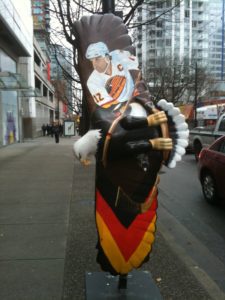
Stan Smyl, #12, 1982 – 1990
While all of the marks would later be broken by Trevor Linden, Markus Naslund and the Sedins, Steamer retired as the franchise leader in seasons of captaincy (8), games played (896), goals (262), assists (411), and points (673), and had his number 12 raised into the rafters in 1991.
Smyl went on to become an assistant coach with the Canucks from immediately following the end of his NHL career in 1991. He stayed in that role until 1999, when he became a head coach of the Canucks farm team for five seasons. After he was let go from that role, he’s been in player development and scouting roles with the Canucks. His current title is Senior Advisor to GM & Director, Collegiate Scouting.
Dan Quinn, #7, 1990 – 1991.
After Stan Smyl’s retirement, the Canucks organization named three co-captains for the 1990-91 season: Dan Quinn, Doug Lidster and Trevor Linden. Quinn was the mysterious choice – he had only played a handful of games in Vancouver after four years each in Calgary and Pittsburgh. He didn’t even complete the 1990-91 season as Canucks co-captain before being traded again – in fact, he ended up playing with seven different teams in five seasons, and missed most of a season with Minnesota as he dealt with rape allegations. After his hockey career, he dabbled in pro golf, both on the celebrity tour and as a caddy to legitimate pro golfers, such as John Daly and Ernie Els.
Doug Lidster, #3, #24 & #25, 1990 – 1991
![Doug Lidster (left) and Willie Desjardins [Credit: Texas Stars]](http://s3951.pcdn.co/wp-content/uploads/2013/09/Doug-Lidster-Willie-Desjardins-575x386.jpg)
Trevor Linden, #16, 1990 – 1997
The most popular Canuck in the team’s 40-year history, Trevor Linden was also one of the youngest captains in league history when he accepted the C at age 21. He played 19 seasons with Vancouver, Montreal, Washington and the New York Islanders (where he was also team captain for one season). Fittingly, 16 of those seasons were spent in Vancouver.
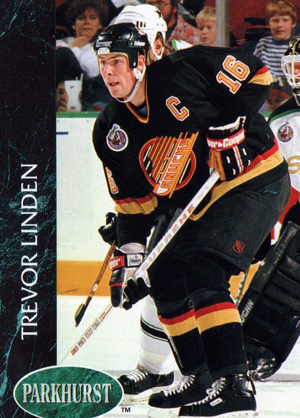
Linden scored 30 or more goals in six of his first eight seasons, and was the heart and soul of the 1994 team that came within a goalpost of sending Game Seven of the Stanley Cup final to overtime. In that game, he famously rallied his team by scoring two goals with cracked ribs, but was unable to pull off the miracle win. Gutting it out through ailments and injuries were nothing new for Linden – between 1990 and 1996, he was the NHL ironman, playing in 482 consecutive games.
Upon the arrival of Mark Messier in 1997, Linden stepped down as team captain out of respect for the six-time Cup winner. He was later traded by GM and coach Mike Keenan, and Vancouver fans often refer to the no-Linden era as the darkest time in team history. Linden would return to finish his career in Vancouver, playing there from 1988-98 and 2001-08. He had his number retired there shortly afterwards in the 2008-09 season.
Linden’s leadership was also evident off the ice, when he was the NHLPA’s president from 1998 to 2006. Aside from that, he was a visible face in the Lower Mainland for many years during “retirement.” He went on to form well-known chain of gyms in Greater Vancouver called “Club 16,” which will have ten locations as of 2019.
More notably, Linden was named President of the Canucks in 2014. He held the role for four seasons, before “amicably parting ways” with the organization in the summer of 2018, after four seasons on the job. Linden and his wife, Cristina, also had their first child, called Roman, in January of 2018.
Mark Messier, #11, 1997 – 2000
Mark Messier is easily the least popular captain in Canucks history. Not only did Messier help the Edmonton Oilers kick Vancouver around the rink throughout the 80s, he captained the New York Rangers to the 1994 Stanley Cup – where they beat the Canucks in one of the most entertaining seven-game finals in decades. To make matters worse, he swaggered into Vancouver, took the C from fan favourite Trevor Linden, and demanded to wear his customary #11 – despite the fact that no Vancouver player had worn it since Wayne Maki’s tragic death in 1974.
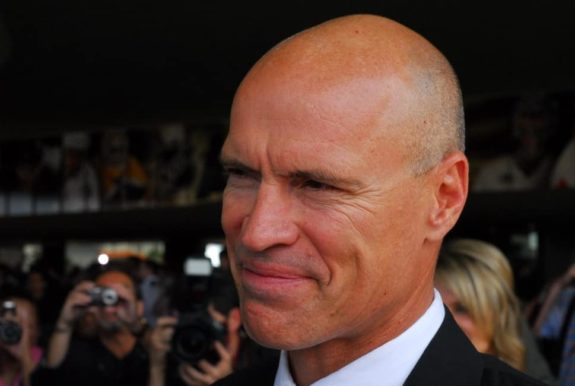
I suppose it all would have been okay had he brought Vancouver the Cup as he’d done for New York three years earlier. Unfortunately, Moose put up the three worst points-per-game seasons of his career, and the team failed to make the playoffs in each of those years. Both Messier and Keenan put in passionless performances in Vancouver, and it was contagious. Other players and team staffers echoed fan sentiments, that this time was “the team’s darkest hour”. At the end of the 1999-2000 season, when Messier reconciled as a free agent with the New York Rangers, Canuck fans cheered – season ticket sales jumped almost immediately.
Even with his sub-par performance wearing the Orca, Messier is the second-leading scorer in NHL history, with 1,887 points over 25 seasons. Counting regular season and playoff games, he is the NHL’s all-time leader in games played. He was inducted into the Hockey Hall of Fame in 2007. He is involved with the New York Rangers and Canadian National Men’s Team organizations, and has been a spokesman against headshots in hockey. He has been attached to studies on concussions in sport, as well as the controversial “Bubble Helmet”.
Markus Naslund, #19, 2000 – 2008
After the game’s meanest captain in Mark Messier, the Canucks went in a completely different direction, giving Markus Naslund the captaincy. The choice was widely criticized by the city’s media and many fans, as Naslund was quiet, unassuming – and perhaps worse, he was the first European captain in team history. Interestingly, he credits those three years beside Mark Messier with the blossoming of his leadership skills.
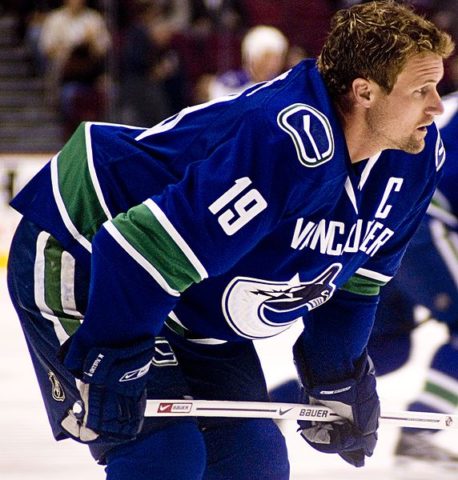
For several years after becoming Canucks captain, Naslund was one of the top scorers in the NHL, and landed numerous corporate sponsorships. As a member of the exciting “West Coast Express” line with Todd Bertuzzi and Brendan Morrison, Naslund led Vancouver in scoring for seven straight years, and captained the club for a franchise-high eight full seasons. He won the Lester B Pearson award as the NHLPA’s Most Valuable Player in 2003, but lost the Hart and Art Ross trophies to countryman Peter Forsberg in a dramatic late-season finish to the scoring race.
Naslund was the Canucks all-time leader in both goals and points when he left, but Henrik Sedin eclipsed the franchise mark in 2013. It took Daniel until 2016 to break Naslund’s goal record, a testament to the former captain’s electrifying ability to put the puck in the net. His number 19 was retired by the Canucks in 2010. Markus Naslund ended up as the General Manager of Modo, the Swedish Elite League team that he broke into the pro ranks with. He’s no longer in that role, but takes part in a number of philanthropic activities in Sweden.
Roberto Luongo, #1, 2008 – 2010
Upon Naslund’s 2008 free agent signing with the New York Rangers, the Vancouver Canucks again went in an odd direction. They named Roberto Luongo as the first goaltender to captain a team since Bill Durnan with the Montreal Canadiens in 1947-48. As the NHL prohibits goalies from performing on-ice captain’s duties, Luongo wore the C on his mask, not his jersey. Luongo was a vocal leader in the dressing room, however – but consecutive Western Conference semifinal losses to the Chicago Blackhawks in 2009 and 2010 led to intense scrutiny of his captaincy by fans and media.
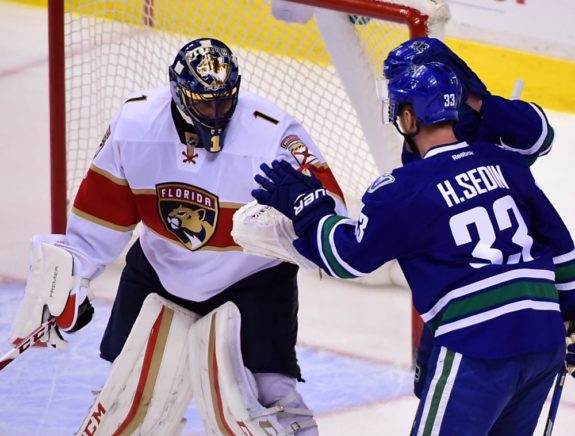
Luongo stepped down during the off-season in 2010. He led the team to a record-setting season, and followed it up by getting to within one win of the 2011 Stanley Cup against the Boston Bruins. The goalie saga that followed between him and Cory Schnieder is one that is well-documented, but it wasn’t until John Tortorella’s snub of Lu at the 2014 Heritage Classic game that a deal finally commenced. Luongo was shipped back to the Florida Panthers, where he continues to perform despite being the oldest goalie in the league. While critics of Luongo were evident in Vancouver, he’s widely considered to be the best goalie in team history.
Henrik Sedin, #33, 2010 – 2018
Henrik Sedin was named the 13th captain of the Vancouver Canucks on the opening day of the 2010-11 season. The previous season, he became the first Canuck to win the Art Ross trophy as the NHL leading scorer, and brought to Vancouver the team’s first-ever Hart trophy as league MVP for good measure. His 112 points stands as the franchise record for most points scored in a single season, two more than Pavel Bure put up in 1993-94.
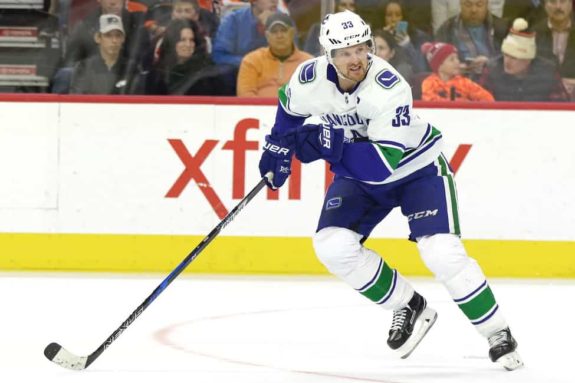
Although Henrik and Daniel Sedin were never able to lead the Canucks back to the promise land, they were easily the two best players this city has never witnessed. Both players surpassed the 1000 point mark in 2017 before retiring at the end of the 2017-18 NHL season. While they seemed to lack recognition and respect around the NHL for years, they were given a huge send-off from teams and fans around the NHL when their retirement was announced.
Aside from handling the media scrutiny that came from playing in Vancouver, Henrik, and Daniel, were two of the most humble and respected leaders that a team could ask for. Although the Canucks didn’t make the playoffs during the last three seasons of their careers, the twins still retired while producing at a top-six rate. As it stands, Henrik Sedin is the most decorated captain in Canucks history.